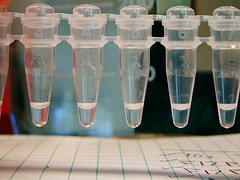Normally you need two primers to amplify your segment of interest – one for the 3′ end of your segment of interest and one for your 5′ end. But if you don’t know the sequence of the regions you’re hoping to amplify this can be a problem! Rapid Amplification of cDNA Ends (RACE) is a PCR protocol that allows you to sequence full-length cDNA from mRNA that has only been partially sequenced.
So How Does RACE PCR Get Around This?
There are two forms of RACE PCR available to you: 3′ RACE and 5′ RACE. Both start with a reverse transcription step to give you cDNA with which to work. What comes next is a little different for each and it all comes down to which segments of the entire sequence you know and which you don’t.
So let’s look at how this is accomplished. And don’t worry I will take this slowly, as it can get a little complicated, and this isn’t a race (tee hee).
5′ RACE: The Basics
This method is the solution if you know the 3′ of your mRNA but not the 5′ end. To work 5′ RACE (Figure 1), also known as ‘anchored’ PCR, requires you to add a 5′ cap to your mRNA. This is cap is added using enzymes that add A- and T-bases. After that, you can then amplify your sequence using a 5′ cap primer and a primer for your known 3′ sequence- easy peasy, right?!
3′ RACE: The Basics
This method is the solution if you know the 5′ of your mRNA but not the 3′ end. 3′ RACE (Figure 2) works by making clever use of the natural poly(A) tail in mRNA, by using the poly(A) tail as a generic priming site for PCR amplification. For 3′ RACE to work, you need to design a primer to the 5′ end of your mRNA and a poly(A) tail (adaptor) primer to mass-produce copies of your unknown sequence.
Okay, yes, it’s super easy when you simplify it down that much. And yes, in reality, it is a little more complicated. On the plus side, both of these methods usually work well. Now let’s take a deeper look. And please note, this technique has many different variations with their own nuances.
Off to the RACEs
The first step is reverse transcription and as you’ve probably already guessed how this is done: Reverse transcriptase in RT-PCR. Nothing unexpected here, but it doesn’t end there. While there are many approaches to this technique, we’ll be looking at this one using this guide as a reference as both are simple to understand and thoughtfully written. Now let’s look:
5′ RACE
Step 1. The cDNA Synthesis Step.
The first step in any RACE experiment is reverse transcription to create your cDNA. The mRNA containing both your known and unknown sequences is used as a template for cDNA synthesis by reverse transcription. First to do this a gene-specific primer (GSP) that is antisense to your known sequence and a reverse transcriptase enzyme is then used to generate cDNA via reverse transcription. Next terminal deoxynucleotidyl transferase (TdT) enzyme is used to add a sequence of thymines, or homopolymeric tail, to the 3′ end of the cDNA.
Step 2. The 5′ RACE Step.
In 5′ RACE you will now use a gene-specific reverse primer (GSRP) against your known sequence and a 5′ universal primer against the cap of T-bases to generate your PCR product. This will create a product composed of your 5′-region of your gene-of-interest nested by the 5?-Primer and GSRP.
3′ RACE
Step 1. The cDNA Synthesis Step.
In 3′ RACE you will take advantage of the natural poly(A) tail in mRNA a generic priming site for PCR amplification. Rather than just using an oligo(dT) primer though, a poly(A) tail adaptor is used. This adaptor is a chain of T bases that bind the complementary poly(A) tail but is preceded by an adaptor sequence.
Step 2. The 3′ RACE Step.
You then amplify the 3′ cDNA from the known region using a sense gene-specific primer (GSP) and an anti-sense primer. This anti-sense primer is complementary to the adaptor sequence you added at the tail in step 1.
In a Nutshell
Both 3′ and 5′ RACE allow you to sequence your unknown sequence via a gene-specific primer and some sort of generic adaptor primer. Making RACE a clever method if you are trying to amplify mRNA of an unknown sequence – a common problem if you work with unusual organisms. And I encourage you to try it.
I hope I helped “e-RACE” any confusion you had about RACE!









